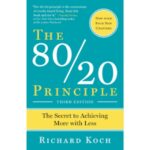LISTEN NOW
Outline: The 80/20 Principle by Richard Koch
Outline
Expand to Read ...
Introduction to the 80/20 Principle
- Definition: The 80/20 Principle states that 80% of results come from 20% of inputs. This imbalance applies universally across professional and personal contexts.
- Examples:
- In business: 20% of products generate 80% of profits; 20% of customers contribute 80% of sales.
- In personal life: 20% of activities yield 80% of happiness; 20% of relationships bring 80% of value.
- Purpose: Helps identify and focus on high-value activities, leading to greater efficiency and satisfaction.
Why the 80/20 Principle Matters
- Benefits:
- Eliminates trivial activities that waste time and energy.
- Enables prioritization of tasks and relationships that contribute most to success and happiness.
- Consequences of Ignoring the Principle:
- Inefficiency and missed opportunities.
- Discontent from focusing on low-impact activities.
Evidence Supporting the 80/20 Principle
- Validation: The principle is observable in real-world scenarios.
- Key Insight: Some inputs consistently exert a disproportionate influence on results, reinforcing the principle unless actively altered.
Adopting the 80/20 Mindset
1. Major Improvements Are Always Possible
- Belief: Significant gains in wealth, happiness, and success can be achieved by focusing on high-impact activities and eliminating excess.
- Action: Expand the 20% of your life that drives the most value.
2. Enjoying Life Is a Duty
- Challenge: Overcome guilt associated with working less and seeking pleasure.
- Mindset: Happiness and ambition can coexist. Pursuing activities you enjoy enhances productivity and overall success.
3. Time Is Abundant
- Reframe Time: Focus on the 20% of tasks that yield 80% of results, freeing up time for meaningful activities.
- Outcome: A sense of abundance and freedom from time scarcity.
Applying the 80/20 Principle for Personal Success
Tip #1: Work Smarter, Not Harder
- Focus on creative and high-impact tasks.
- Decline unnecessary meetings and delegate tasks that aren’t strengths.
Tip #2: Pursue Work You Enjoy and Excel At
- Concentrate on the 20% of your skills that produce 80% of your success.
- Link enjoyment with productivity for greater satisfaction and results.
Tip #3: Build Valuable Relationships
- Cultivate relationships with individuals who bring joy and value.
- Professionally, develop a network of mentors, peers, and mentees to gain diverse insights and knowledge.
Tip #4: Consider Self-Employment
- Self-employment ensures compensation aligns with contributions.
- Employ top performers to maximize profitability.
Tip #5: Create a Daily Happiness Routine
- Dedicate time to activities that bring joy, such as exercise, meditation, or self-care.
Applying the 80/20 Principle to Business
Step 1: Analyze Your Business
- Method #1: Perform an 80/20 Analysis:
- Use data to identify which 20% of products, customers, or employees contribute to 80% of results.
- Method #2: Implement 80/20 Thinking:
- Reflect on general observations to identify high-performing areas.
Step 2: Boost Returns
- Focus on the Top 20%:
- Strengthen relationships with key customers and enhance high-performing products.
- Reassess the Bottom 80%:
- Target marketing efforts or refine offerings for less-engaged customers.
Step 3: Simplify Business Operations
- Delegation: Outsource tasks unrelated to your competitive edge.
- Streamlining Inputs: Eliminate low-profit products, suppliers, and customers.
- Simplifying Management: Flatten organizational structures to enhance customer focus.
Step 4: Strategic Enhancements
- Recruit more top talent with exceptional skills and attitudes.
- Reconnect with previous satisfied customers for repeat business.
- Hire competent project managers to focus teams on vital tasks.
- Innovate through small, practical improvements.
Conclusion
- The 80/20 Principle provides a framework for focusing on what truly matters, both professionally and personally.
- By identifying high-value activities and eliminating inefficiencies, individuals and businesses can achieve greater happiness, productivity, and success.

 Buy on Amazon
Buy on Amazon